| Tuned Percussion | Untuned Percussion |
|---|---|
| Timpani | Drums (slide or snare drum) |
| Xylophone | Cymbals |
| Marimba | Triangle |
| Glockenspiel | Tambourine |
| Kettledrum | Gong |
| Tubular Bells | Castanets |
Back to: Top | Djembe | Tabla | Timpani
The Djembe (African Drums):
What is a Djembe?
African drums, African drums,
Something 'bout your culture hums.
African drums African drums,
Something 'bout your culture numbs.
May 21, 1970
By Linda A. Copp ©
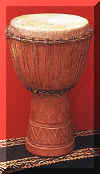 Music and dance have played a major role in the conquests and enthroning of kings, in initiation rites and sacred ceremonies throughout Africa.
Some of these rhythms are now world famous, their voice embodied by the lord of Mandingo instruments, the Djembe.
Music and dance have played a major role in the conquests and enthroning of kings, in initiation rites and sacred ceremonies throughout Africa.
Some of these rhythms are now world famous, their voice embodied by the lord of Mandingo instruments, the Djembe.
This grail-shaped hand drum, known to various tribes in West Africa as the "djembe," (jem-bay) is central to the musical heritage of the Malinke and Sousou tribes of Guinea in West Africa. The common cultural and historical roots of these tribes can be traced to the great Mali Empire which once encompassed all of present-day Mali as well as most of the coastal regions of West Africa.
While the djembe is not necessarily an integral component of the "Griot tradition, it has always played a significant role in the celebration of sacred and secular events among the Malinke and Sousou tribes. The true complexity and beauty of this tradition lies in the fascinating interplay between the three accompanying bass drums called, in the Malinke tongue, "doundoun" (better known in the United States perhaps as "djundjun" or "junjun"), "sangban" and "kenkeni."
A bell is hung from each of the three drums which is struck with the left hand while the right hand strikes the cowhide head with a wooden stick. The amalgamation of the two rhythms produced in this manner forms one coherent melody.
 |
| Moussa Traoré |
Moussa Traoré is a very accomplished Malian "jembefola," which means "player of the jembe" in his language of Bambara (Bamanankan). Moussa has been playing the jembe for the past twenty-five years.
Since moving to the U.S. in 1998, Moussa has performed and taught in cities across the country. Currently residing in Boston, Moussa teaches weekly drum classes, gives private lessons, drums for four weekly West African dance classes and performs throughout New England.
For more information on the DJEMBE Click Here
Back to: Top | Djembe | Tabla | Timpani
The Tabla:
What is a Tabla?
Indian music has fascinated the West for many years. The tabla in particular has attracted the attention of a number of American and European percussionists. It has been used in popular music as early as the 60's and is heard in the popular media even today. However, many percussionists shy away from this instrument. The reasons for not "getting into it" are varied. Sometimes it is the lack of instruments; sometimes lack of teachers; sometimes it is the belief that tabla is just too difficult. These are legitimate concerns but they are not insurmountable obstacles.
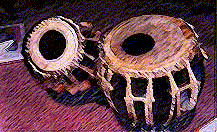
Tabla has a position in both rag and tal. When numerous tabla are tuned to the notes of the scale, entire melodies may be played. This is called "Tabla Tarang". However, the most important use of tabla is to provide the tal. It is in this capacity that most people think of the instrument.
The word "tal" literally means "clap". The clapping of hands may be the oldest form of rhythmic accompaniment. Today, a system of claps and waves forms a conceptual common ground. It is common to the way instrumentalists, dancers and vocalists think of rhythm. There are similarities between Western and Indian rhythm. Western rhythm may function at the level of beats, measures or even longer cycles. The same is true of Indian rhythm.
Tabla was popularised as a solo instrument, initially, by Alla Rakha and has now been immortalised by his son, Zakir Hussain.
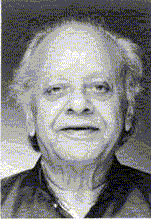 |
 |
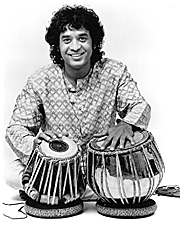
|
| Alla Rakha | Alla Rakha & Zakir Hussain | Zakir Hussain |
For more information on the TABLA Click Here
Back to: Top | Djembe | Tabla | Timpani
The Timpani:
What is a Timpani?
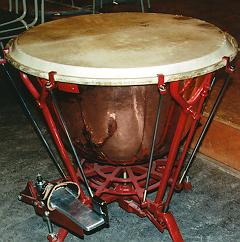
Another term for the Timpani is the Kettledrum. This instument consists of hollow hemispheres of copper or brass with a parchment head stretched across the top. The head can be tightened or loosened to change the pitch. Screws around the head are used to tighten for fine tuning, and a foot pedal is used to change the pitch during a performance. The tension around this head can be controlled to produce difnite pitches by adjusting the screws or pressing on a pedal mechanism. The drummer uses fourteen-inch wooden sticks with both hard and soft heads. Different sonorities are possible by striking the membrane with these sticks, the heads of which may be equipped with a variety of soft or hard materials.
Earlier versions of the drum were flatter than today's and were slung on both sides of a horse so that a mounted player could beat them while riding. Turkish armies used them when fighting Crusaders in 1300. Today, the timpanist stands or sits on a chair surrounded by five different-sized kettledrums arranged in a semi-circle, the instruments resting in cradles of crossed sticks or on metal frames. A timpanist needs to be a perfectionist. One mistake, and the whole audience knows it. The timpani is the nucleus of the percussion family. It is the most important orchestral percussion instrument.
The Timpani can puncuate orchestral statements, giving shart definition to rhythms, make colossal crescendos by the drumroll technique, and point up climaxes.
 Click icon to hear the TIMPANI
Click icon to hear the TIMPANI
 |
| Roland Kohloff |
Roland Kohloff, a native New Yorker, has been Principal Timpanist of the New York Philharmonic since 1972 when he succeeded his former teacher, Saul Goodman. Previously, he was principal timpanist of the San Francisco Symphony and the San Francisco Opera Orchestras where he appeared frequently as soloist.
Since 1978 Mr. Kohloff has been a faculty member of The Juilliard School. He has also performed and taught at the Aspen Music Festival and in 1991 gave the New York Premiere of the Timpani Concerto by Siegfried Matthus with the New York Philharmonic.
For more information on the TIMPANI Click Here
Back to: Top | Djembe | Tabla | Timpani
Christine Williams & Mitul Sanghvi
Last Revised: January 14, 2002
All Rights Reserved
Void where prohibited
 Contact: soundsofmusic02@hotmail.com
Contact: soundsofmusic02@hotmail.com
Home Page | Brass | Percussion | Strings